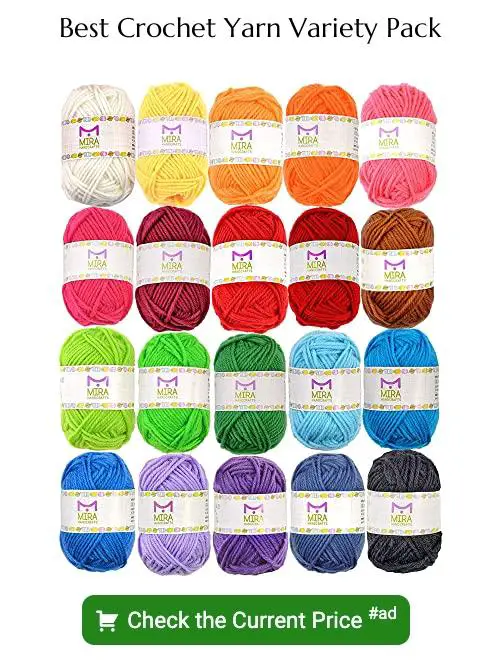Discover the diverse world of crochet by exploring various types of yarn, perfect for creating stunning projects that will leave you hooked.
Crocheting is an art form that has been around for centuries, and it’s no wonder why. With just a hook and some yarn, you can create beautiful and intricate designs that are both functional and fashionable.
But with so many different types of yarn available, how do you know which one to choose? In this article, we’ll explore the various types of yarn that are commonly used in crocheting. Whether you’re a seasoned pro or just starting out, understanding the differences between these different yarns will help you create stunning projects that will stand the test of time.
So grab your hook and let’s get started!
Fiber Type
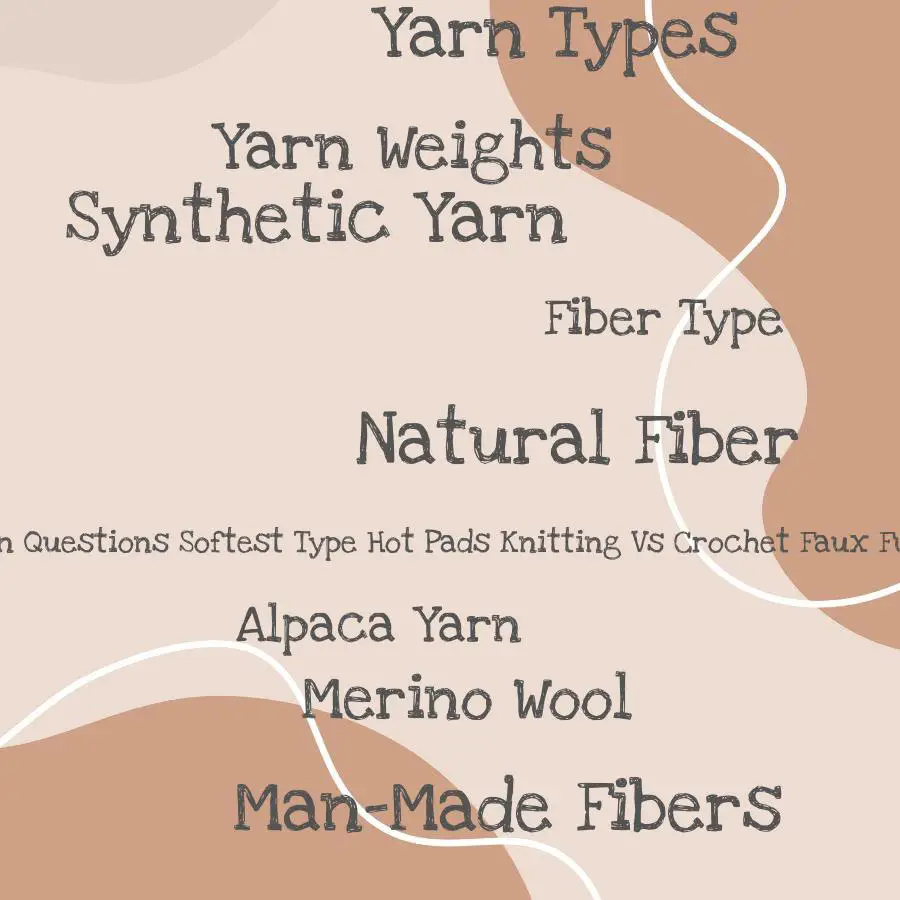
Different fibers have different properties that can affect how your finished project looks and feels. Some fibers are soft and warm, while others are durable and easy to care for.
Natural fiber yarn types include wool, alpaca, cotton, bamboo among others. Wool is a popular choice because it’s warm and has natural elasticity which makes it great for garments like sweaters or hats that need some stretchiness.
Alpaca yarns tend to be softer than wool but still provide warmth without being too heavy.
Cotton is another popular choice as its lightweight nature makes it perfect for summer projects such as beach bags or tops; however cotton does not have much elasticity so you may want to blend with other materials if you’re making something fitted.
Bamboo on the other hand has a silky texture similar in feel with silk itself but less expensive than silk; this material drapes beautifully making them ideal choices when crocheting shawls or scarves.
Yarn Vs. Thread
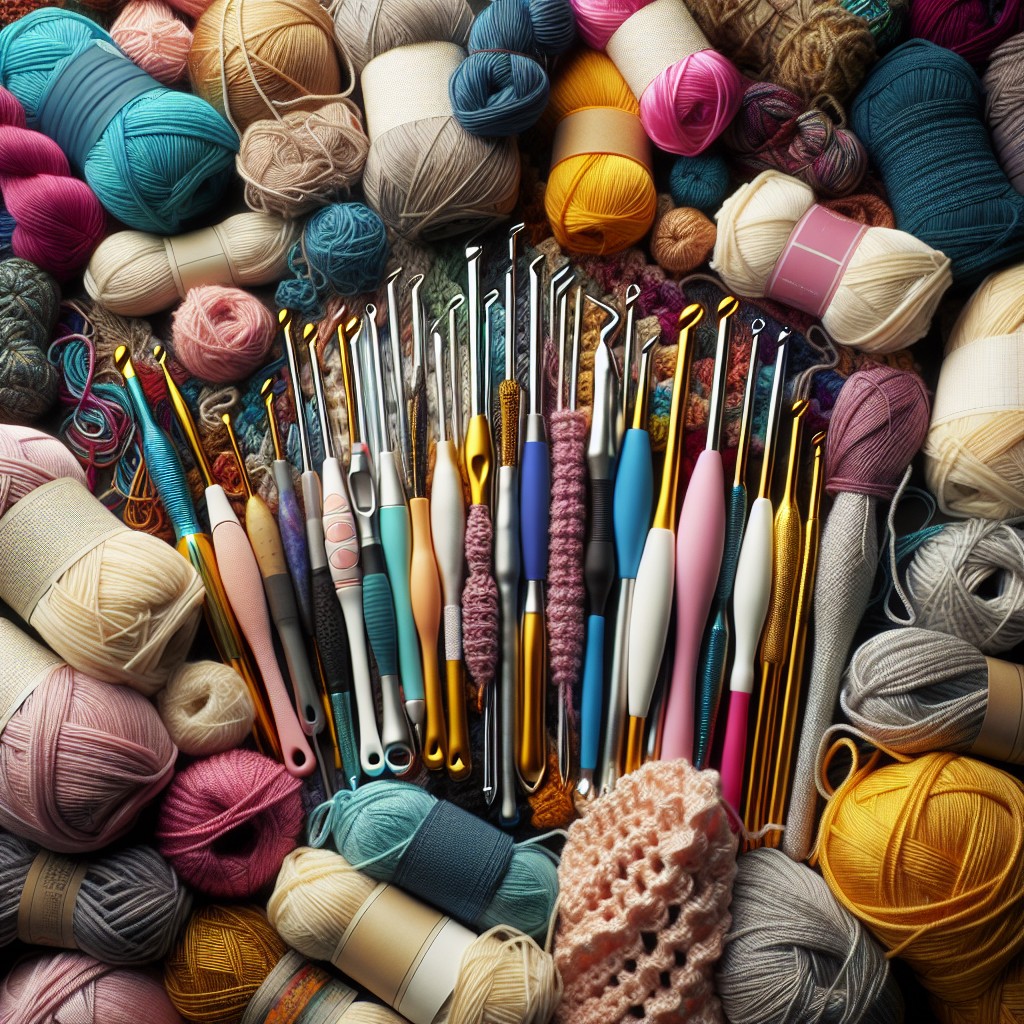
While they may seem interchangeable, there are some key differences between the two that can affect your project’s outcome.
Yarn is typically thicker than thread and is made up of multiple strands twisted together. It comes in a variety of weights, from super fine to super bulky.
Yarns can be made from natural fibers like wool or cotton or synthetic fibers like acrylic.
Thread, on the other hand, is much thinner than yarn and usually consists of just one strand. It’s often used for delicate projects such as doilies or lacework where a finer texture is desired.
Choosing between yarn and thread depends on what you’re making – if you’re creating something with intricate details that require precision work then using crochet threads would be ideal while larger projects will benefit more from using thicker types of yarns.
Yarn Weights
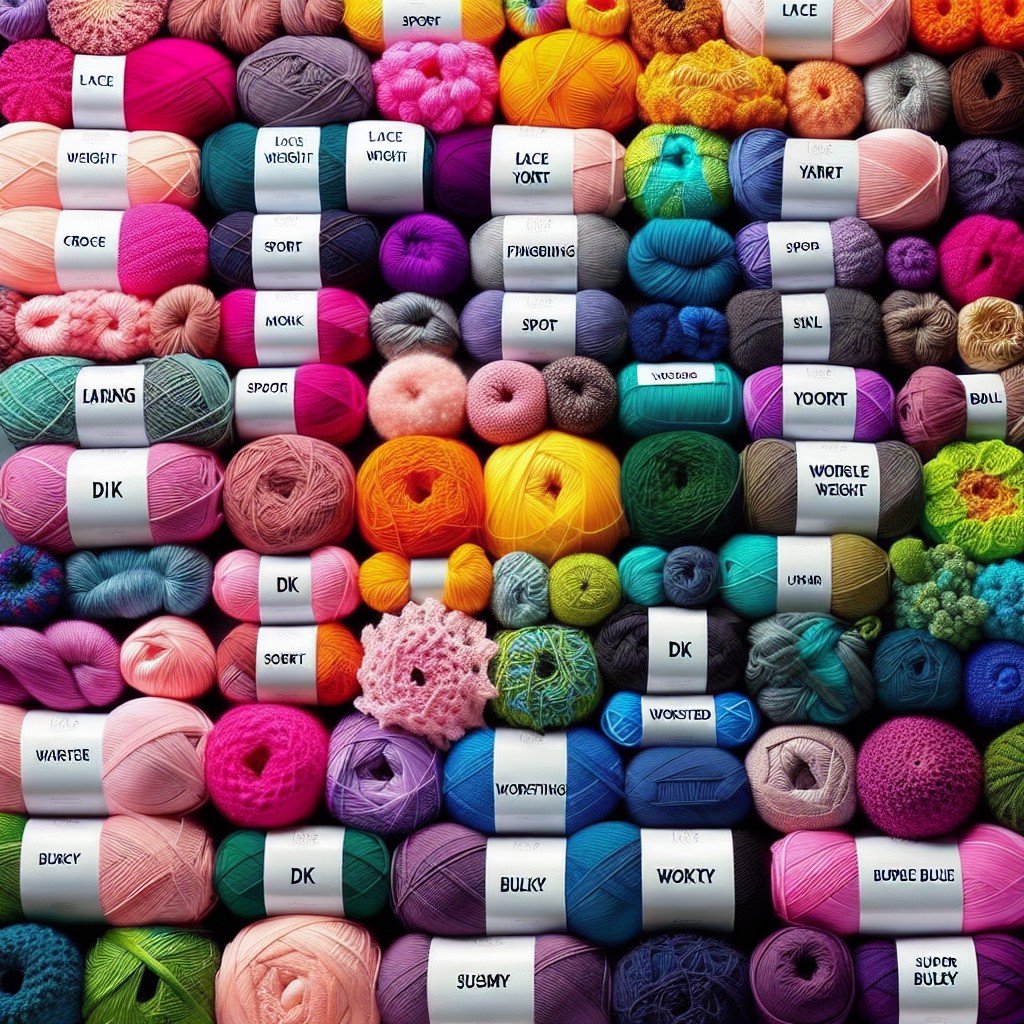
Yarn weight refers to the thickness of the yarn and is categorized by a numbered system ranging from 0 (lace) to 7 (jumbo). The weight of your chosen yarn will determine how delicate or bulky your finished product will be.
For example, if you’re looking to create a lightweight shawl or scarf, then lace-weight yarn would be ideal. On the other hand, if you want something more substantial like a cozy blanket or sweater, then chunky-weight yarn would work best.
It’s important to note that different brands may have slightly different interpretations of what constitutes each weight category. So it’s always best practice to check with both pattern requirements and recommended hook size before purchasing any new type of wool.
Natural Fiber Yarn Types
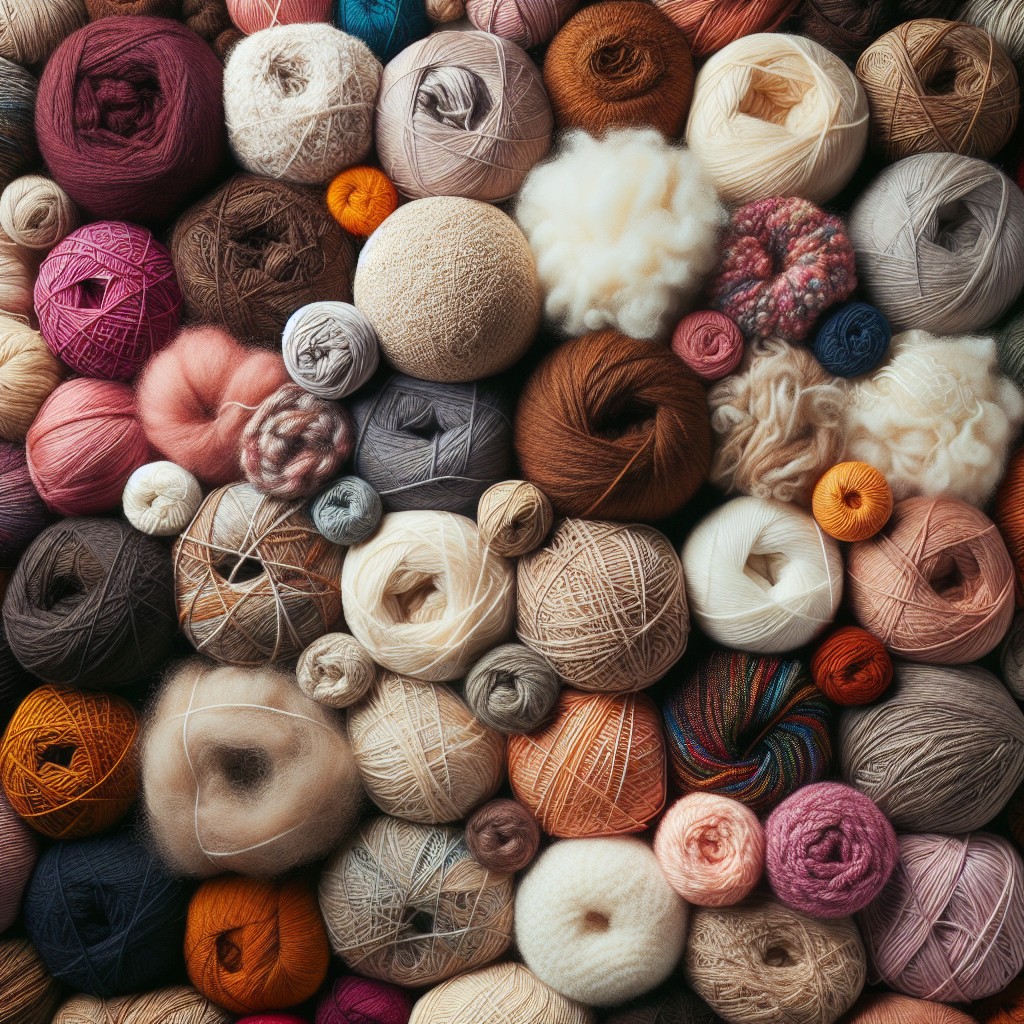
These yarns are made from natural materials such as wool, alpaca, cotton or bamboo. Wool is one of the most commonly used natural fibers in crochet projects because it’s warm and soft to the touch.
Alpaca yarn is also a great option for those looking for warmth without bulkiness.
Cotton is another popular choice for crocheting because it’s lightweight and breathable making it perfect for summer garments like tank tops or beach cover-ups. Bamboo has become increasingly popular in recent years due to its silky texture that drapes beautifully when worked up into shawls or scarves.
Synthetic Yarn Types (Man-Made Yarn Fibers)
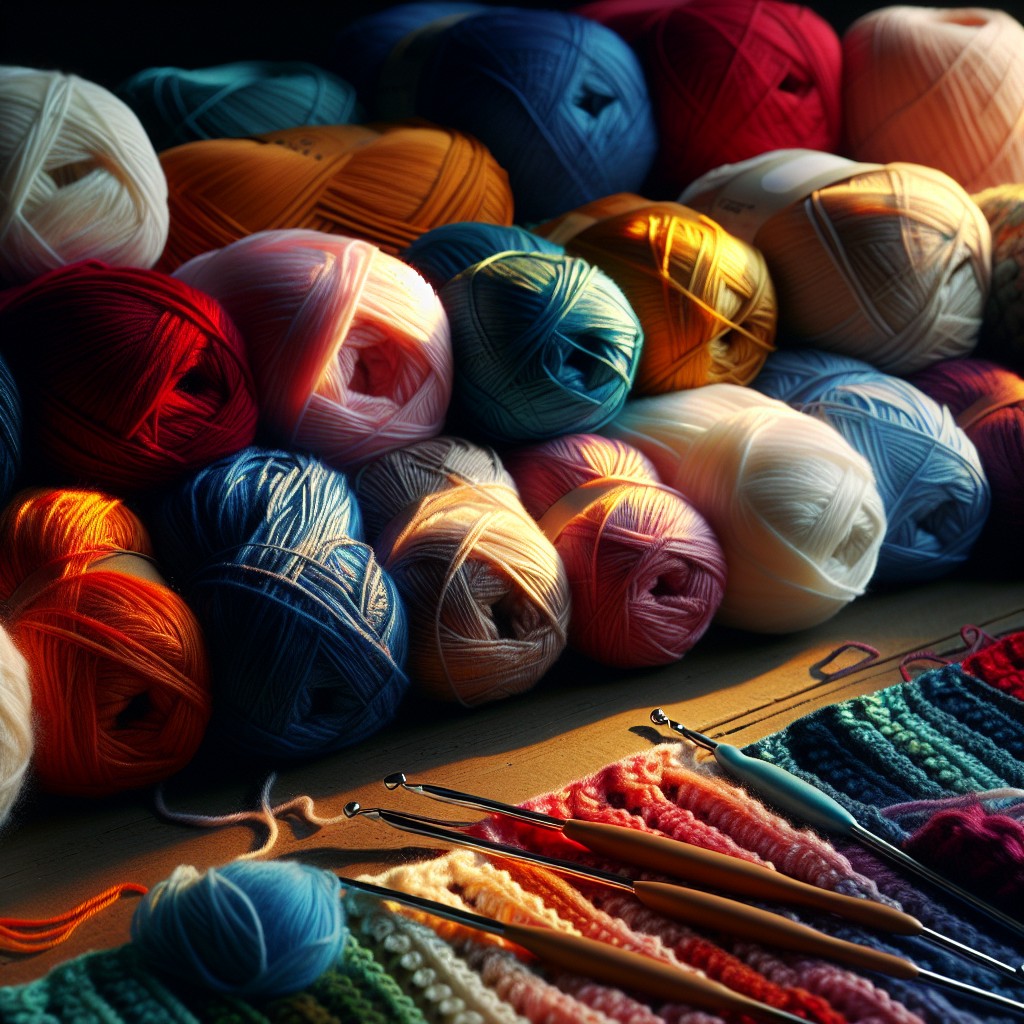
These man-made fibers are created using chemical processes that mimic natural fibers like wool or cotton. They come in a wide range of colors and textures, making them perfect for creating bold and vibrant projects.
One popular type of synthetic yarn is acrylic yarn. This versatile fiber is easy to work with, soft to the touch, and comes in an array of bright colors that won’t fade over time.
It’s also machine washable which makes it ideal for items like blankets or children’s clothing.
Another popular choice is nylon yarn which has excellent durability properties making it great for socks or other high-wear items.
Polyester blends are another common type of synthetic fiber used in crocheting as they offer both strength and elasticity while being lightweight at the same time.
Types of Yarn Weights
Yarn weight refers to the thickness of the yarn and determines how much yardage you’ll need for a particular pattern. The most common types of yarn weights are lace, fingering, sport, DK (double knitting), worsted/aran (medium), bulky and super bulky.
Laceweight is incredibly thin and delicate; it’s perfect for creating intricate designs such as shawls or doilies. Fingering weight is slightly thicker than lace but still lightweight enough to create delicate projects like socks or baby clothes.
Sport-weight yarns are ideal for lightweight garments such as sweaters or cardigans while DK-weight works well with hats and scarves because they’re not too heavy yet provide warmth in cold weather.
Worsted/aran-weight is one of the most popular types used in crochet projects due to its versatility – suitable for anything from blankets to clothing items like jumpers. Bulky-weights work great when you want something chunky quickly – think cozy winter accessories! super-bulky weights will give you instant gratification by working up fast into thick blankets that will keep you warm all winter long!
Merino Wool
This type of yarn comes from Merino sheep, which are known for their fine and soft wool fibers. The fibers in Merino wool are much finer than traditional sheep’s wool, making it softer to the touch and less likely to cause itching or irritation.
One of the benefits of using Merino wool in your crochet projects is that it has excellent temperature regulation properties. It can keep you warm when it’s cold outside but also wick away moisture when you’re sweating, keeping you cool during warmer weather.
Another advantage of using this type of yarn is that it comes in a wide range of colors and weights, making it perfect for creating everything from cozy blankets to delicate shawls or scarves.
When working with merino wool yarns be sure not wash them too often as they tend shrink easily if washed frequently. Also avoid washing them at high temperatures as this may damage the fiber quality leading to pilling on your finished project.
Wool
It’s a natural fiber that comes from sheep, and it has many desirable qualities that make it perfect for creating cozy and warm projects. Wool is known for its softness, warmth, durability, and elasticity.
It’s also naturally flame-resistant and water-repellent.
There are different types of wool available depending on the breed of sheep they come from. Merino wool is considered to be one of the finest wools available due to its softness and fine fibers which make it ideal for next-to-skin wearables like scarves or hats.
When working with wool yarns in crochet projects you should keep in mind that they can shrink when washed if not treated properly so always follow washing instructions carefully.
Alpaca Yarn
This type of yarn comes from the fleece of alpacas, which are native to South America. Alpaca fibers are naturally hypoallergenic, making them an excellent option for those with sensitive skin.
One unique characteristic of alpaca yarn is that it can come in a range of natural colors, including white, black, brown and gray. The fiber itself has a natural sheen that gives finished projects an elegant look.
When working with alpaca yarns in crochet projects it’s important to keep in mind their weight as they tend to be heavier than other types such as cotton or acrylics. It’s also essential not to overwork the material when crocheting since this could cause pilling or stretching out over time.
Bamboo
It’s made from bamboo grass, which grows quickly and doesn’t require the use of pesticides or fertilizers. Bamboo yarn is also incredibly soft and has a beautiful drape, making it perfect for creating lightweight garments like shawls or scarves.
One thing to keep in mind when working with bamboo yarn is that it can be slippery, so you may need to adjust your tension accordingly. Because bamboo fibers don’t have as much elasticity as other types of yarns like wool or acrylics, you’ll want to avoid using it for projects that require a lot of stretch.
Fabric / T-Shirt
It’s an eco-friendly option for those who want to reduce waste and create something unique at the same time. This type of yarn can be used for a variety of projects, including rugs, bags, and even clothing items like scarves or hats.
One advantage of using Fabric/T-Shirt Yarn is that it’s very soft and comfortable to work with. The texture makes it perfect for creating cozy blankets or pillows that you’ll love snuggling up with on cold winter nights.
Another benefit is its affordability; since this yarn can be made from old clothes you no longer wear, it costs next to nothing! Plus, by repurposing your old t-shirts into something new and useful instead of throwing them away in the trash bin helps reduce textile waste which has become one major environmental issue globally.
Acrylic Yarn
It’s made from synthetic fibers, which means it’s easy to care for and can be machine washed without losing its shape or color. Acrylic yarn comes in a wide range of colors, making it perfect for creating vibrant projects that pop.
One of the benefits of using acrylic yarn is that it doesn’t shrink or felt like natural fibers such as wool do. This makes it an excellent choice for items that will see frequent use, such as blankets or scarves.
Another advantage of acrylic yarn is its durability. It holds up well over time and won’t pill like some other types of fiber might.
Plus, because acrylic isn’t prone to moth damage like wool can be, you don’t have to worry about storing your finished projects with mothballs.
Cotton
It’s also affordable and widely available in many different colors. Cotton yarn is perfect for creating lightweight garments like summer tops or baby blankets that won’t be too warm or heavy.
One of the benefits of cotton yarn is that it can be machine washed and dried without losing its shape or color. This makes it ideal for items that will need frequent washing like dishcloths, washcloths, or kitchen towels.
When choosing cotton yarns to crochet with, there are several factors to consider such as weight (thickness), texture (smooth vs textured), ply (number of strands twisted together) and color availability. Some popular brands include Lily Sugar ‘n Cream Cotton Yarns which come in a variety of weights from worsted weight up through bulky; Bernat Handicrafter Cotton Yarn which comes in both solid colors as well as variegated shades; Peaches & Creme 100% Mercerized Cotton Yarn which has a lustrous sheen due to the mercerization process used during production.
Cotton Threads
They come in a variety of weights and colors, making them perfect for creating everything from delicate doilies to sturdy dishcloths.
One of the benefits of using cotton thread is that it is absorbent, which makes it ideal for items like washcloths or towels. It also holds up well over time and can be machine washed without losing its shape or color.
When choosing cotton thread for your project, consider the weight you need based on what you’re making. A thinner weight will create more delicate designs while a thicker weight will produce sturdier pieces.
Another thing to keep in mind when working with cotton thread is that it has less stretch than other types of yarns. This means that tension control becomes even more important as uneven stitches can cause puckering or distortion in your finished piece.
Natural & Acrylic Mixes
These blends offer the durability and affordability of synthetic fibers with the softness and breathability of natural fibers. They are also easy to care for, making them ideal for everyday use.
One popular example is wool-acrylic blend yarns which combine warmth with washability. Another great option is cotton-acrylic blends which provide excellent stitch definition while still being lightweight.
When choosing a natural/acrylic mix, it’s important to consider what type of project you’ll be working on as well as your personal preferences in terms of texture and feel. Some people prefer all-natural fibers while others like the convenience and affordability that comes with synthetic materials.
Common Questions About Yarn Types
Here are some common questions that people ask about yarn types:.
– What is the Softest Type of Yarn? The softness of a yarn depends on its fiber content. Some natural fibers like alpaca or cashmere tend to be softer than synthetic fibers like acrylic.
– What Type of Yarn Should I use for Hot Pads? When it comes to hot pads, it’s important to choose a heat-resistant material such as cotton or wool.
– Is Yarn Different for Knitting vs Crochet? While there is no difference in the actual type of yarn used between knitting and crochet, some people prefer certain textures or weights depending on their preferred craft.
– What is Faux Fur Yarn Made Of? Faux fur yarn can be made from various materials including polyester and nylon blends that mimic real animal fur without harming animals in any way.
What Is the Softest Type of Yarn?
If you’re looking for a soft and cozy feel, then you’ll want to choose a yarn that’s known for its plushness. But what is the softest type of yarn?
The answer depends on personal preference and project needs. However, some popular options include cashmere, alpaca wool blends or pure alpaca wool as well as merino wool.
Cashmere is one of the most luxurious fibers available in knitting and crochet world; it’s incredibly soft but also expensive due to its rarity.
Alpaca fiber has become increasingly popular among crafters because it’s hypoallergenic (making it perfect for those with sensitive skin), lightweight yet warm like sheep’s wool but without any itchiness associated with traditional wools.
Merino Wool is another favorite among knitters/crocheters because not only does this fiber have an ultra-soft hand-feel but also offers excellent stitch definition making intricate patterns stand out beautifully while being machine washable which makes cleaning easy!.
What Type of Yarn Should I Use for Hot Pads?
The best type of yarn for this purpose is 100% cotton. Cotton has a high tolerance for heat, making it perfect for use in kitchen items like hot pads and pot holders.
Not only does cotton have excellent thermal properties, but it’s also easy to clean and maintain. You can machine wash your cotton hot pads without worrying about them losing their shape or color.
Another benefit of using 100% cotton yarn is that it’s widely available in different colors and weights. This means that you can easily find the perfect shade to match your kitchen decor while still ensuring functionality.
Is Yarn Different for Knitting Vs Crochet?
The answer is no, there isn’t necessarily a specific type of yarn that’s better suited for one craft over the other. However, certain types of projects may require different weights or textures of yarn.
For example, crochet typically requires more yardage than knitting due to its looser stitches and higher stitch count per square inch. This means that you may need to purchase more skeins or balls of yarn when crocheting compared to when knitting.
Some crochet stitches can be harder on certain fibers than others due to their tightness and tension requirements. For instance, acrylics are great for beginners because they’re easy-care and affordable but might not hold up as well in intricate lacework patterns where cotton would be better suited.
What Is Faux Fur Yarn Made Of?
But what exactly is faux fur yarn made of? Unlike traditional animal fibers like wool or alpaca, faux fur yarn is typically made from synthetic materials such as polyester or acrylic. These man-made fibers are designed to mimic the look and feel of real animal fur without harming any animals in the process.
One benefit of using faux fur yarn in your crochet projects is that it’s often more affordable than natural fiber options. It also comes in a wide range of colors and textures, making it easy to find the perfect match for your project.
However, there are some downsides to consider when working with this type of material. Faux fur can be difficult to work with due to its tendency to shed or tangle easily.
It may also require special care when washing or blocking your finished project.
How Is Self Striping Yarn Made?
This type of yarn creates stripes as you work, without the need to change colors or weave in ends. But have you ever wondered how self-striping yarn is made?
Self-striping yarn is created by dyeing sections of the skein with different colors in a repeating pattern. The length and width of each section can vary depending on the desired stripe size and pattern.
Once dyed, these sections are wound into one continuous skein, creating an effect that looks like stripes when worked up.
The beauty of self-striping yarn lies in its ability to create intricate designs without much effort from the crafter. It’s perfect for projects such as socks, scarves or shawls where color changes would be difficult or time-consuming.
When working with self-stripping yarns it’s important to keep track of your starting point so that your project has consistent strip widths throughout; otherwise, it may look unevenly striped at some points while others will appear more solid-colored than striped.
What Type of Yarn Is Best for Crocheting Blankets?
You want a yarn that is soft and cozy, yet durable enough to withstand frequent use and washing. One popular option for crocheting blankets is acrylic yarn.
Acrylic is affordable, easy to find in a variety of colors and weights, and machine washable – making it perfect for creating practical items like blankets.
Another great option for crocheting blankets is wool or wool blends. Wool has natural insulating properties that will keep you warm on even the coldest nights while still being breathable enough not to overheat you during warmer months.
If you’re looking for something more luxurious than acrylic or wool blends but still want durability in your blanket’s fibers then consider alpaca yarns which are incredibly soft with excellent drape qualities.
Dye Techniques
That’s why it’s important to understand different dye techniques and how they affect the final product. Self-striping yarn is perfect for creating stripes without having to change colors, while ombre creates a gradient effect from light to dark.
Speckles add pops of color throughout the yarn, while semi-solid creates an even tone throughout.
Color pooling is another technique that involves strategically placing stitches in order to create patterns with variegated yarns. This technique requires some planning but can result in stunning designs.
When choosing dyed yarns, keep in mind that each skein may vary slightly due to differences in dye lots or application methods used by manufacturers.
Self-Striping
This type of yarn is perfect for creating projects with multiple colors without having to switch between different skeins. Self-striping yarn comes in a variety of color combinations, from bright and bold to subtle and muted tones.
The way self-striping works is by using pre-dyed sections within the same skein or ball of yarn. As you work through your project, the colors will change automatically, creating beautiful stripes without any extra effort on your part.
One thing to keep in mind when working with self-striping yarn is that it can be difficult to match up the stripes perfectly if you’re making something like socks or gloves where both pieces need to match. However, this can also add an element of uniqueness and charm to your finished project.
Ombre
This effect can be achieved with any type of yarn, and it’s perfect for creating stunning gradient effects in your crochet projects. Ombre yarns are available in both natural and synthetic fibers, making them versatile enough to use for a wide range of projects.
When using ombre yarns, it’s important to pay attention to the direction of the color changes. Depending on how you work up your project (whether you’re crocheting back-and-forth or working in rounds), the colors may appear differently than they do on the skein.
One way to ensure that your ombre colors transition smoothly is by using multiple skeins at once and alternating between them every few rows or rounds. This will help blend any abrupt changes between skeins and create a more cohesive look overall.
Speckles
This dye technique involves adding small, random specks of color throughout the yarn, creating a unique and eye-catching effect. Speckled yarns can be found in both natural fiber types like wool or alpaca as well as synthetic blends like acrylic.
When working with speckled yarns, it’s important to consider how the colors will play out in your project. Depending on the pattern you’re using, certain areas may highlight or obscure different parts of the speckling effect.
It’s also worth noting that not all skeins of speckled yarn will look exactly alike – each one is truly one-of-a-kind!
If you’re looking for inspiration on how to use this type of yarn in your crochet projects, consider trying out patterns that feature simple stitches or textures so that they don’t compete with the boldness of the colors themselves. Scarves and shawls are great options for showcasing these unique colorways.
Semi-Solid
It’s perfect for those who want to add some depth and interest to their projects without overwhelming the design. Semi-solid colors are created by using one dye bath, which results in a range of shades within the same color family.
This technique creates subtle variations that can add texture and dimensionality to your crochet work.
When choosing semi-solid colored yarn, it’s important to consider how it will complement your project’s overall look and feel. For example, if you’re making a scarf or shawl with intricate stitch patterns, you may want to choose a semi-solid colorway with lighter tones so as not to detract from the stitchwork.
Semi-solid colored yarns offer an excellent option for crocheters looking for something between solid colors and variegated hues when creating their projects’ designs.
Color Pooling
This technique works best with variegated yarns, which have multiple colors throughout the skein. By carefully selecting where you place each color, you can create stunning patterns that are sure to impress.
To achieve color pooling, it’s important to pay attention to the length of each color section in your yarn. You’ll want to make sure that each section is long enough so that when crocheted together, they form distinct stripes or pools of color.
One popular way of achieving this effect is by using what’s known as the moss stitch (also called linen stitch). This stitch alternates between single crochets and chain stitches across rows creating an interesting texture while also allowing for easy manipulation of where certain colors fall within your work.
Spin Styles
There are several different spin styles to choose from, each with its own unique characteristics. Mercerized yarn has been treated with sodium hydroxide to increase its luster and strength, while loosely spun yarns tend to be softer and more pliable than tightly spun ones.
Tightly-spun yarns are great for creating defined stitches that hold their shape well over time. Roving-style spinning creates a thick, fluffy texture that’s perfect for cozy blankets or scarves.
When choosing your spin style, consider the type of project you’re working on as well as your personal preferences in terms of texture and appearance. Experimenting with different types of spins can help you discover new techniques and create truly one-of-a-kind pieces.
Understanding the various types of yarn available is essential when it comes to crocheting successfully.
Mercerized
This process causes the fibers in the yarn to swell, giving it a smooth and shiny appearance. Mercerized cotton is perfect for creating garments that require a bit of sheen, such as summer tops or dresses.
One benefit of using mercerized cotton is its durability. The treatment process makes the fibers stronger than regular cotton, which means your finished project will hold up well over time.
Mercerized cotton takes dye exceptionally well due to its smooth surface texture.
When working with mercerized yarns in crochet projects, keep in mind that they tend to be less stretchy than other types of natural fiber yarns like wool or alpaca. However, this can be an advantage when creating items like dishcloths or coasters where you want them to maintain their shape after repeated use.
Loosely Spun
This type of yarn is perfect for creating lightweight and breathable garments such as summer tops or shawls. Loosely spun yarn can also be used to create textured stitches like bobbles or popcorns.
When working with loosely spun yarn, it’s important to keep in mind that it can be more delicate than tightly-spun varieties. It may not hold up well under heavy wear or frequent washing, so it’s best suited for projects that won’t see too much use.
Tightly Spun
Tightly spun yarn is made by twisting fibers together tightly during the spinning process. This type of yarn is great for creating defined stitches and intricate patterns because it holds its shape well.
Tightly spun yarns are often used for projects that require structure, such as bags or baskets. They also work well for amigurumi toys because they hold their shape and don’t stretch out over time.
However, tightly spun yarns can be more difficult to work with than loosely-spun varieties since they have less give and may not glide as smoothly on your hook. If you’re new to crocheting or prefer a softer feel in your finished product, you might want to opt for a looser-spun variety instead.
Roving
This process creates a thick, fluffy yarn that has an almost cloud-like texture. Roving can be used for many different types of projects, including scarves, hats, and even blankets.
One of the benefits of using roving in your crochet projects is its unique texture. The thickness and fluffiness make it perfect for creating cozy winter accessories or adding extra dimension to your designs.
However, because roving tends to be thicker than other types of yarns like fingering or sport weight yarns; it may not work well with all patterns. It’s important to keep this in mind when selecting patterns so you can choose one that will work best with the thickness and texture of the roving.
T-Shirt
It’s made from recycled t-shirts, which are cut into strips and then spun together to create a continuous strand of yarn. This eco-friendly option not only repurposes old clothing but also creates an incredibly soft and durable material.
T-Shirt Yarn is perfect for creating projects such as rugs, baskets, bags, or even home decor items like pillows or wall hangings. Its thickness makes it easy to work with and allows you to quickly complete your project.
One thing to keep in mind when working with T-Shirt Yarn is that the weight can vary depending on the thickness of the t-shirt used. So be sure to check the weight before starting your project so you can adjust accordingly.
Chainette
This unique construction gives the yarn a soft and lightweight feel, making it perfect for creating delicate and airy projects such as shawls or scarves. The chainette structure also provides excellent drape, allowing your finished project to flow beautifully.
One benefit of using chainette yarn in your crochet projects is its versatility. It can be used alone for lightweight garments or combined with other types of yarn to add texture and interest to bulkier items like blankets or sweaters.
When working with chainette yarn, it’s important to keep in mind that because it’s so light and airy, you may need more yardage than you would with other types of heavier weight yarns. However, the end result will be worth the extra effort as this type of fiber creates stunningly beautiful pieces.
Fiber Types
Different fibers have different properties that can affect everything from how easy they are to work with, to how warm and durable your finished project will be.
Animal fibers like wool and alpaca are popular choices for many crocheters because they’re soft, warm, and come in a variety of weights. Plant-based fibers like cotton or bamboo tend to be cooler than animal-based ones but offer excellent breathability making them perfect for summer projects.
Synthetic yarns such as acrylic or nylon may not have the same natural feel as animal or plant-based options but offer durability at an affordable price point. Blends combine two or more types of fiber together which can create unique textures while still maintaining some desirable qualities from each individual material.
Ultimately when selecting a fiber type you should consider what kind of texture you want in your final product along with any other specific needs based on its intended use (e.g., washability).
Synthetic Yarns
They are often less expensive than natural fiber yarns and can be easier to care for, making them a popular choice among crocheters. Some common types of synthetic yarn include acrylic, nylon, polyester, and rayon.
Acrylic is one of the most commonly used synthetic yarns in crocheting due to its affordability and versatility. It’s easy to work with and comes in a wide range of colors.
Nylon is another popular option as it has excellent durability and strength.
Polyester is known for its resistance against wrinkles, shrinking or stretching which makes it ideal for projects like blankets or scarves that require frequent washing without losing their shape.
Rayon has a silky texture similar to silk but at an affordable price point compared with real silk fiber which makes it perfect for creating elegant garments such as shawls or dresses.
Animal Fibers
These types of yarns come from animals such as sheep, alpaca, and even rabbits. Wool is one of the most popular animal fibers used in crocheting due to its warmth and versatility.
It’s also available in different weights depending on your project needs.
Alpaca yarn is another popular option for those who want a soft yet strong fiber that can be used for various projects like scarves or sweaters. Alpaca wool comes from the South American alpacas which produce some of the finest quality wool with natural insulation properties.
Angora rabbit hair produces one of the softest types of yarn available but it’s not as durable compared to other animal fibers like wool or alpaca so it may not be suitable for all projects.
When working with these types of animal-based materials, keep in mind that they require special care when washing them since they tend to shrink if exposed to high temperatures or agitation during cleaning.
Plant Fibers
These fibers come from plants such as cotton, bamboo, and linen. Cotton is a widely used plant fiber that is known for its softness and durability.
It’s perfect for creating items like dishcloths or baby blankets because it can withstand frequent washing without losing its shape or texture.
Bamboo yarn is also becoming increasingly popular due to its eco-friendliness and silky texture. This type of yarn has natural antibacterial properties which make it ideal for creating garments that will be worn close to the skin.
Linen yarn comes from the flax plant and has been used in textiles for thousands of years due to its strength and ability to absorb moisture. It’s perfect for summer clothing as it keeps you cool even on hot days.
Blends
They can be made up of natural fibers, synthetic fibers, or both. Blending yarns together can create unique textures and colors that cannot be achieved with single fiber yarns alone.
For example, a blend of wool and silk creates a soft yet durable fabric with an elegant sheen. A blend of cotton and acrylic is perfect for creating lightweight garments that are easy to care for.
When choosing blends, it’s important to consider the properties each fiber brings to the mix. For instance, if you’re looking for warmth in your project but want something machine washable then you might choose a wool/acrylic blend as opposed to 100% wool which requires special care when washing.
Pick the Right Yarn for Your Projects
The type of project you’re working on will determine which type of yarn is best suited for it. For example, if you’re making a blanket or scarf, you’ll want a soft and warm fiber like wool or alpaca.
If you’re making dishcloths or hot pads, cotton is an excellent choice because it’s absorbent and durable.
Another factor to consider when choosing your yarn is its weight. Yarn weights range from super fine (also known as lace weight) all the way up to super bulky.
Each weight has its own unique characteristics that make it suitable for certain projects.
It’s also important to consider any special care instructions required by your chosen fiber type before starting your project so that they can be properly maintained over time.
FAQ
What type of yarn do you use for crochet?
Answer: The best yarn for crochet, especially for beginners, is a DK weight yarn made of acrylic, wool, or cotton, as it maintains uniform thickness and allows for easy correction of errors.
Can you use any type of yarn for crochet?
Answer: Yes, you can use various types of yarn for crochet, but beginners should begin with easier options to work with.
What are the 3 types of yarn?
The 3 types of yarn are Animal Fibers, Plant Fibers, and Synthetic Fibers.
What type of yarn is best for beginners?
The best type of yarn for beginners is a thicker-knit yarn, ranging from medium size (worsted-weight) to heavy, chunky yarn, as it is easier for them to see what they are doing.
What are the differences between yarn fibers used for crochet?
Answer: The differences between yarn fibers used for crochet include factors like thickness, texture, elasticity, and type of material like cotton, wool, or acrylic.
How do yarn weights affect crochet projects and outcomes?
Yarn weights significantly impact crochet projects and outcomes as they determine the thickness and appearance of the final product, ultimately influencing its overall texture, drape, and use.
Can you mix different types of yarn in a single crochet project?
Yes, you can mix different types of yarn in a single crochet project to achieve various textures and patterns.
